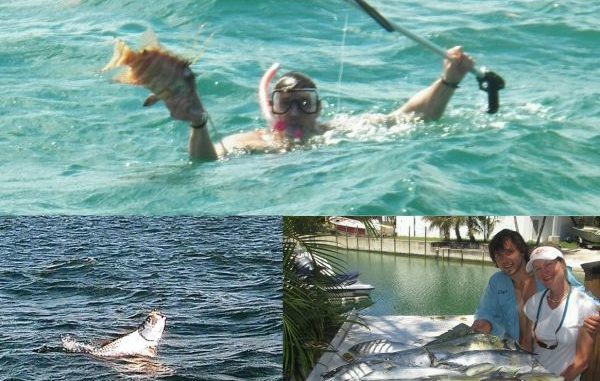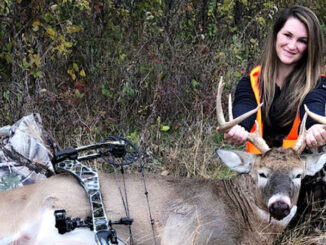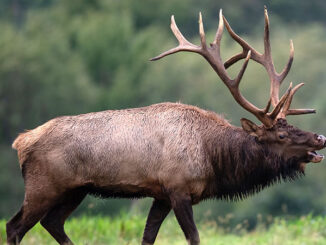
Keys provide different experience, with great nearshore fishing and spring tarpon run
Recently I went on a 10-day fishing excursion for my honeymoon to a place where an island is known as a key and the ocean view will take your breath away. A few friends told me this is the only fishery that can compare to coastal Louisiana.Plus, with marrying an adventuress fisherwoman of a wife, it sounded like the perfect place.
The Chauvins were headed to the Florida Keys.
We decided to fly, but if going on a road trip, the drive is about 16 hours. Southwest Airlines is the only airline to fly directly from New Orleans to Key West at the moment. I’ll take that route next time, as flying with delays in Atlanta was no fun.
The fishing licenses are reasonably priced. We opted for a week-long license that was under $30 per person; the non-resident yearly license cost just under $50 per person.
Many of the fish are the same species as here in Louisiana, but the water and tactics used to catch them are different. The water color is an amazing spectacle, possessing every shade of green to blue imaginable. Practically all of the inshore fishing needs to be done with fluorocarbon leaders.
Instead of fishing oil wells as in the Gulf, most of the fishing is done around coral reefs and sunken debris.
To find out more about the fishing, I had to pull a Jeremy Wade move, from the show “River Monsters,” by talking to the locals to discover the methods that work best there.
Unlike down here in the South where everyone is “give you the shirt off your back” friendly, many of the folks in the Keys are “keep to yourself” northerners, who moved there to retire. However, with some smooth talking in the gym, bars and bait shops about my Louisiana adventures they soon had spilled all their secret spots and tricks to these friendly Cajun honeymooners.
A lot of great fishing can easily be done from the bank or a kayak in the Keys. Our back dock had plenty of mangrove snapper to catch. At night, I had loads of topwater action from blue runners and different species of jacks.
But most of our action came on the 31-foot Contender my buddy keeps down in the Keys. He took us fishing five times throughout our trip for only the cost of boat fuel. However, he only knew about fishing tarpon and a tad of offshore fishing. For years he has gone to the Keys in April to May and urging me to join, since that’s when the tarpon fishing is at its best during the full moons.
He used to fish a smaller 18-foot bay boat in these waters before getting his larger vessel. Even though we passed through the Atlantic Ocean, a bay boat is all you really need, as most of the waters are very shallow, allowing wave heights to remain at bay.
For the entirety of our trip, the April winds were blowing near 20 mph, so going far offshore wasn’t an option. Though we did go trolling two to four miles off the coast and caught many little tunny, a mahimahi, Spanish mackerel and some cero mackerel trolling along a few weed lines and drops-offs near the coral reefs.
Similar to trolling in Louisiana, many of colorful plugs rigged with ballyhoo worked, but we by far had the most success trolling the pink-and-white Williamson’s diamond jet feather with sonic strip that I bought.
Fishing with live shrimp and squid near coral reef drop-offs put all kinds of fish in the boat, including countless species of snapper. We never knew what kind of fish was on the line.
Grouper season was closed, so we released all the pretty groupers we caught. It was similar to rig fishing out on our coast, except all these fish were caught less than two miles from the house.
Being that I only have a small bay boat, getting to the blue water around our coast is not an option, so I never before tried spearfishing. Since that was something I always wanted to do, on the first day of our trip I bought a small speargun.
Many of the coral reefs are near the shore, so spearfishing can be done from a small boat even when seas are rough. The reefs can be seen easily on maps with depth markings.
I was able to spear several snapper. Then, on the last day of my trip, I speared one of the highly sought-after hogfish. Many of the locals had hogfish decals on their trucks. It wasn’t until I put that hogfish in the skillet that I found out why: Besides the striking appearance of this fish, it is one of the best-tasting fillets I have ever eaten.
Snorkeling the reefs and seeing all the tropical fish was an experience like no other. Doing it with a speargun in your hand to stick dinner is even better.
A neat way to spearfish while free diving is to get pulled behind the boat very slowly with the assistance of a throw ring. This way you can cover more ground to locate fish and productive coral heads without working as hard. I experienced tenfold the underwater creatures trolling myself versus plain swimming.
When I saw a legal fish, I just let go the ring and dove down for the hunt.
Another tactic I used was chumming the fish up. Though I learned when chumming the waters while spearfishing not only do the fish become friendlier, but the sharks become overly friendly.
But I still prefer being in water where I can see the sharks, compared to a surf-fishing experience in Louisiana, when I felt tugging on my stringer but couldn’t see how large the shark was as it viciously ate my strung fish next to my leg.
I was interested in fishing giant sharks, but my friend with the boat was terrified of them, whereas I kept trying to swim after them while free diving to see which species lurked the waters.
Next trip I might bring my wife’s scuba gear and take spearfishing to the next level, as she told me many fun stories about her previous dives. Also, I really wanted get on some bonefish and permit action, but we needed a smaller boat to hit the shallow Gulf-side flats.
One of the popular free-diving sports down there is lobstering, but the season was closed in April. There were hundreds of these big spiny lobsters — or as I was calling them, “monster ocean crawfish” — all along the reefs.
The real fun came from the adrenalin rushes in the Bahia Honda Channel as we chased tarpon on three occasions. This is one of the deepest Gulf-to-Atlantic channels in the Keys and has the thickest concentration of tarpon roaming during the spring.
The first day out, there were thousands upon thousands of these 50- to 200-pound fish rolling out of the water. But getting them to bite is tricky.
Needed is a light, 12-foot 40-pound fluorocarbon leader with a balloon and a small circle hook on each end with a small split shot 4 feet up of the hook.
The best bait was a live 2- to 3-inch blue crab hooked through the back swimmer. The bait was only hit by free-lining it along with the current. Any fluorocarbon over 40-pound test was untouched, and any hook over 3/0 was not only un-bit but usually too thick to hook the small crab without killing them. Crab had to be very lively, and in contrast to Louisiana the crabs are hard to come by out there — they cost nearly $4 apiece.
Many of the dozens of boats were fishing the same rig, and those were the only boats besides us hooking up. We tried many different types of bait, line setups and artificially, but this was the only rig that worked.
The tarpon fed the best right as the tide began to move slowly from the pauses of the two-a-day high/low tides they have. When the water is dirtier from windy conditions and strong tides, the bite is better although with very clear water, either lighter line or night fishing must be utilized to fool these smart fish.
With the two bridges that the tarpon roll between, fighting these fish seemed to be an impossible task on the light line. Too loose of a drag and we were instantly popped in the bridge post. Too tight and the fish freely swam away with my hook still in its mouth.
If you forget to point-the-rod down when the fish leaps, the line is cut as the fish lands on it. We snapped off countless times and straightened or broke six hooks.
Once you get fish away from the underwater obstructions and dozens of other boats, the challenge only gets harder because these fish enjoy jumping every couple of minutes and seem to never tire.
Laura got hooked on the action a couple times. After many break-offs, I was able to battle one for over 45 minutes. Between airborne leaps and getting the line tangled in a crab pot, from which I miraculously got untwisted, we got my fish boat-side several times.
Besides some video footage of this whopper slashing the surface every few minutes, this still-green fish never wore enough to land for a picture before the line gave way. Next trip my goal is to rebattle and put my hands on one of these sporting “silver kings.”
A similar comparison would be to imagine battling a lively ladyfish along the Louisiana coast. These so-called “poor man’s tarpon” or “banana fish” are cousins to tarpon and fight similarly with their constant tail-walking acrobatics — except tarpon are usually 50 times bigger.
Tarpon can be caught this way or by trolling artificials on the eastern end of our coast in the passes in the late summer months, but don’t expect a hook up every five to 10 minutes as it is in Bahia Honda ,where volume of fish is one of the largest in the world.
The tarpon found near the Mississippi River migrate along the 78-degree temperature line from either Florida or the Bay of Campeche after their spring spawn. Then, in October when the temperature drops, the fish head back south.
Tarpon, at over 100 million years old, are one of the oldest fish in the world and have been around since the dinosaurs. Similar to a bowfin (aka choupique), tarpon can breathe air on the surface — which is why they roll. This allows them to survive in low-oxygen waters.
Another neat adventure in the keys is to travel to Big Pine Key, which is a 30-minute drive north of Key West, to see the endangered tiny Key deer. This subspecies of white-tail roam the streets of Big Pine all day long, with many of the full-grown does only reaching 40-pounds. Most of these wild deer are extremely tame and don’t even bother moving when you walk by at arm’s length.
I went on trail runs and saw and dozens of Key deer on each run. One buck even nudged up against Laura as she stopped for a breather to take pictures. I’m sure he was looking for food, but it’s illegal to feed these deer. It was surreal to have these wild deer approach me when I’m so used to spending all winter back home trying to approach them.
There were all kinds of other animals we had never seen before like giant sea turtles and big 5-foot iguanas. All of our pictures from the trip can be found on my Facebook page.
We stayed on Summerland Key; if you’re into the night life, Key West is the place for you. It was very similar to Bourbon Street in New Orleans, except it’s much cleaner and safer.
There are plenty of art shops, museums and places to visit, but we spent our time on Key West competing in three road races. Fueled by fresh mango juice and coconut milk from our yard, we won medals as souvenirs of our trip.
Even with 10 days, I didn’t get to experience half the types of fishing or activities available there. There is so much diversity amongst the species and styles of fishing in the Keys, just as it is back home. Still, no place can compare with the sheer volume of fish Louisiana has to offer, but the keys are a close second.
We are spoiled to have such great fresh, brackish and saltwater to fish within such close proximity.
Like my buddy who spends a month in the Keys every year to fish the tarpon, I’ll be back, hopefully on a yearly basis, toting my own boat to enjoy those beautiful waters with my friends and family.
Louisiana still remains No. 1, in my opinion. We Louisianans are truly blessed to be able to experience such vast numbers of fish in the murky bayous of our own backyard. But down on the southernmost corner of our nation, there exists some truly phenomenal fishing — and I recommend all serious saltwater anglers experience the Florida Keys.

